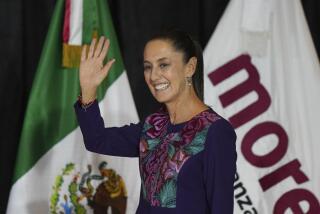Mexico’s Economy Hits 6-Year High Note
- Share via
MEXICO CITY — Mexico’s economy expanded at the fastest clip in six years in the first three months of 2006, a performance that analysts say could help boost the electoral chances of the ruling conservative party.
The nation’s economic output grew 5.5% from the January-March period last year, the Treasury Ministry said Wednesday. Construction activity grew at a blistering 8.3% pace, thanks to a government-led housing push, and the factory sector accelerated 7.1% on revved-up auto production. Those are the two main drivers of industrial activity, which expanded 7%. Mexico’s service sector also extended its solid run with 5.4% growth.
The results were the best showing under the waning six-year term of President Vicente Fox, who hasn’t made good on campaign promises to deliver millions of new jobs and robust economic growth.
But with just over six weeks to go before the July elections, the economic results come at an opportune time for conservative presidential candidate Felipe Calderon. The presidential front-runner is vying to succeed fellow National Action Party member Fox, who is barred by law from seeking a second term.
A Harvard-educated technocrat and fan of free-market economics, Calderon is pushing Mexico to move farther down the road of privatization and globalization. It’s a message that might sway some voters to Calderon’s camp, experts say, now that the economy finally is showing signs of life.
“Rightly or wrongly, the pickup will be associated with the Fox administration,” said Alberto Ramos, an emerging-markets analyst with Goldman Sachs & Co. in New York. “Certainly the rebound of economic performance early this year has helped Calderon.... He is associated with the establishment.”
Analysts said Mexico was benefiting from the solid growth of its largest trading partner: the United States. Record remittances from Mexicans working north of the border have likewise lifted the economy, along with sky-high oil prices that have left Mexico’s treasury flush with petrodollars.
“The question is how long that can last,” said Gray Newman, senior Latin America economist for Morgan Stanley in New York.
Indeed, global stock markets swooned Wednesday on a worse-than-expected U.S. inflation report. Investors fear that the Federal Reserve may sharply hike interest rates, putting the brakes on U.S. consumers whose appetite for imports has helped power a global economic boom.
That would be bad news for Mexico, which ships more than 90% of its exports to the United States.
“If we see a U.S. slowdown, we’re going to see some slowing in Mexico as well,” Newman said.
A couple of seasonal gimmicks put a little extra kick into Mexico’s strong first-quarter numbers, analysts said. A late Easter holiday meant that the January-March period had more working days than the same period last year, boosting production proportionally. In addition, the federal government has stepped up spending in an election year, adding some juice to this quarter’s growth.
The presidential race has become something of a referendum on the nation’s economy, free trade and neo-liberal economic policies, which have delivered mixed results in the world’s 10th-largest economy.
Government austerity and tight money management after the mid-’90s peso crisis have lowered interest rates, tamed inflation and stabilized Mexico’s currency, helping both rich and poor. But Mexico’s economy has performed miserably in terms of growth of gross domestic product, which is the estimated value of all goods and services produced. Economic growth has averaged less than 2% annually in the first five years of Fox’s term. Meanwhile, the informal economy of off-the-books workers has been the only reliable job engine.
Mexico’s economy needs to grow at least 6% a year to create the estimated 1 million additional jobs needed annually just to keep up with its growing population. Illegal immigration to the United States is at an all-time high, with more than 400,000 Mexicans fleeing north each year in search of better opportunities.
Calderon wants to create jobs by liberalizing the nation’s rigid labor code and opening its state energy monopolies to private investors to improve service and bring down rates.
His leading opponent, left-leaning Andres Manuel Lopez Obrador of the Democratic Revolutionary Party, wants to stimulate the economy with public works projects that would provide employment while bolstering the nation’s crumbling infrastructure. Obrador also seeks to boost Mexico’s dismally low tax collection through better enforcement to provide more social spending in a nation where nearly half the population lives in poverty.
More to Read
Sign up for Essential California
The most important California stories and recommendations in your inbox every morning.
You may occasionally receive promotional content from the Los Angeles Times.













